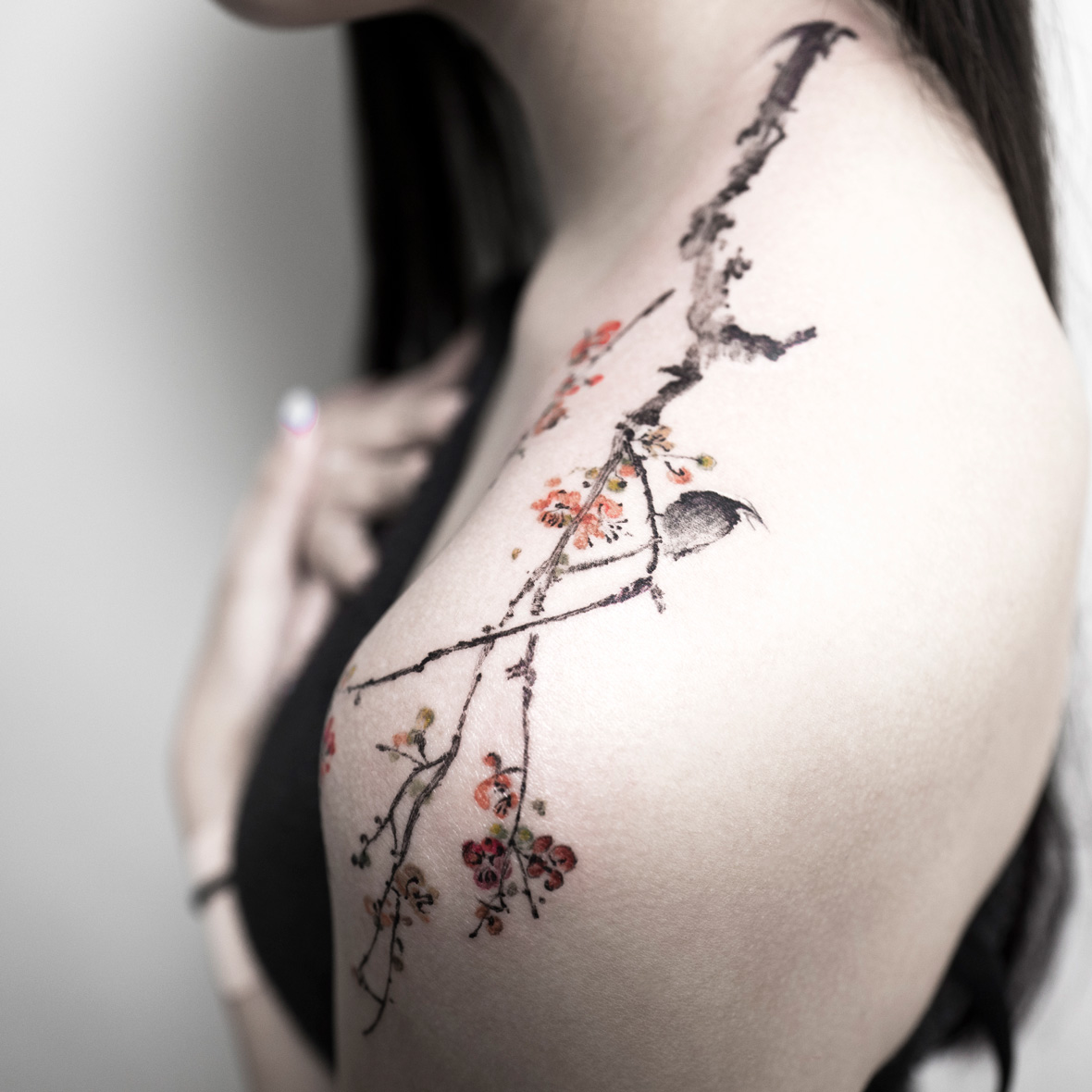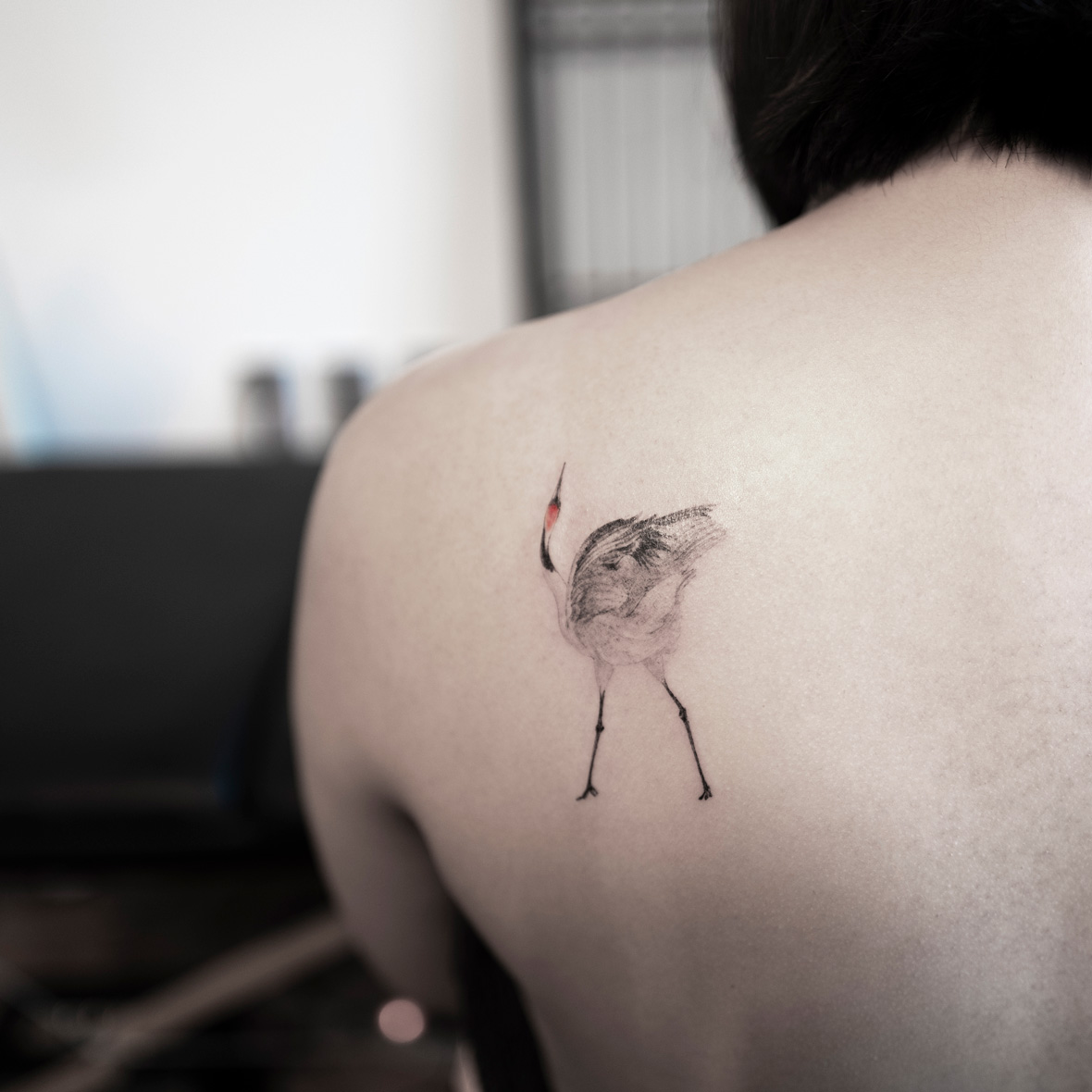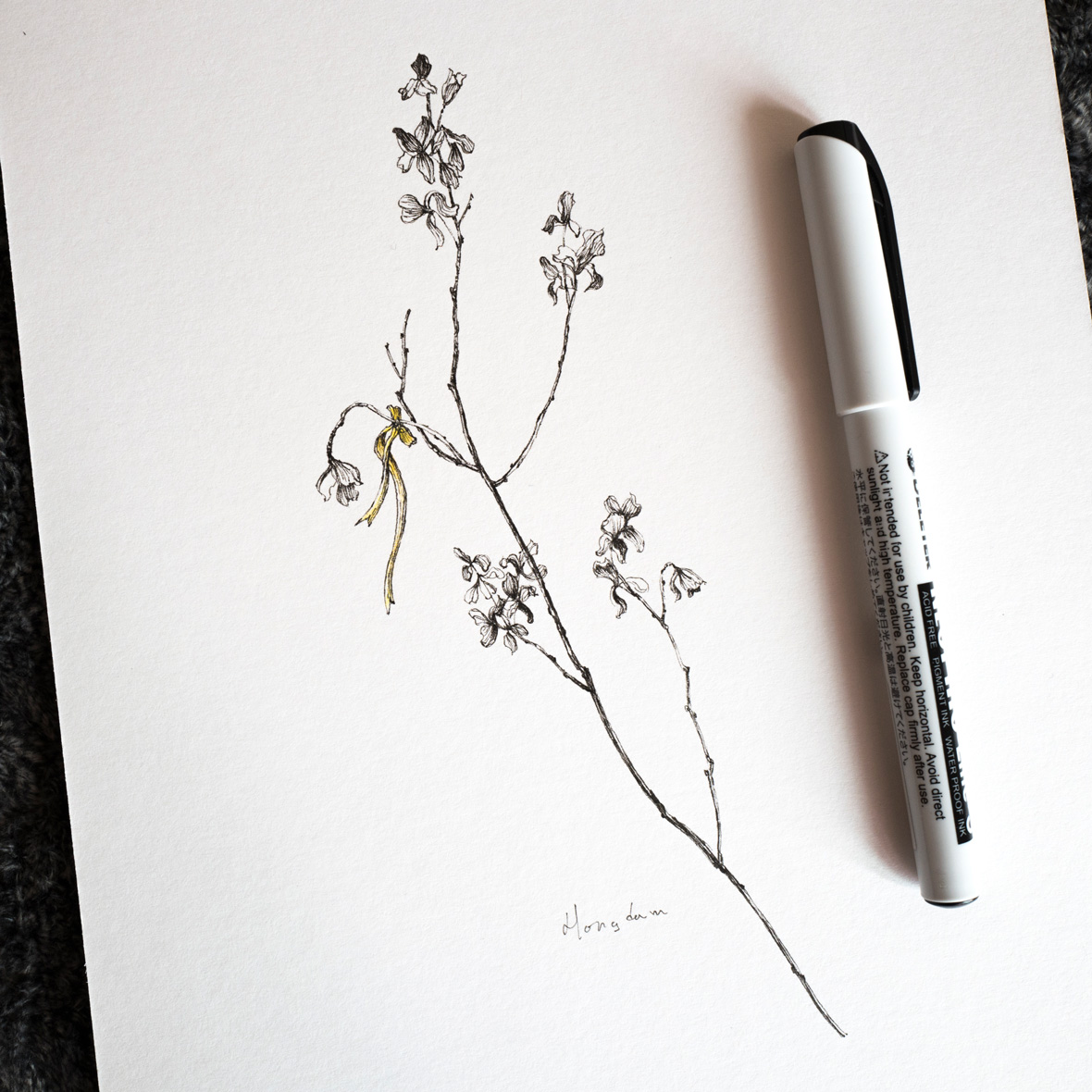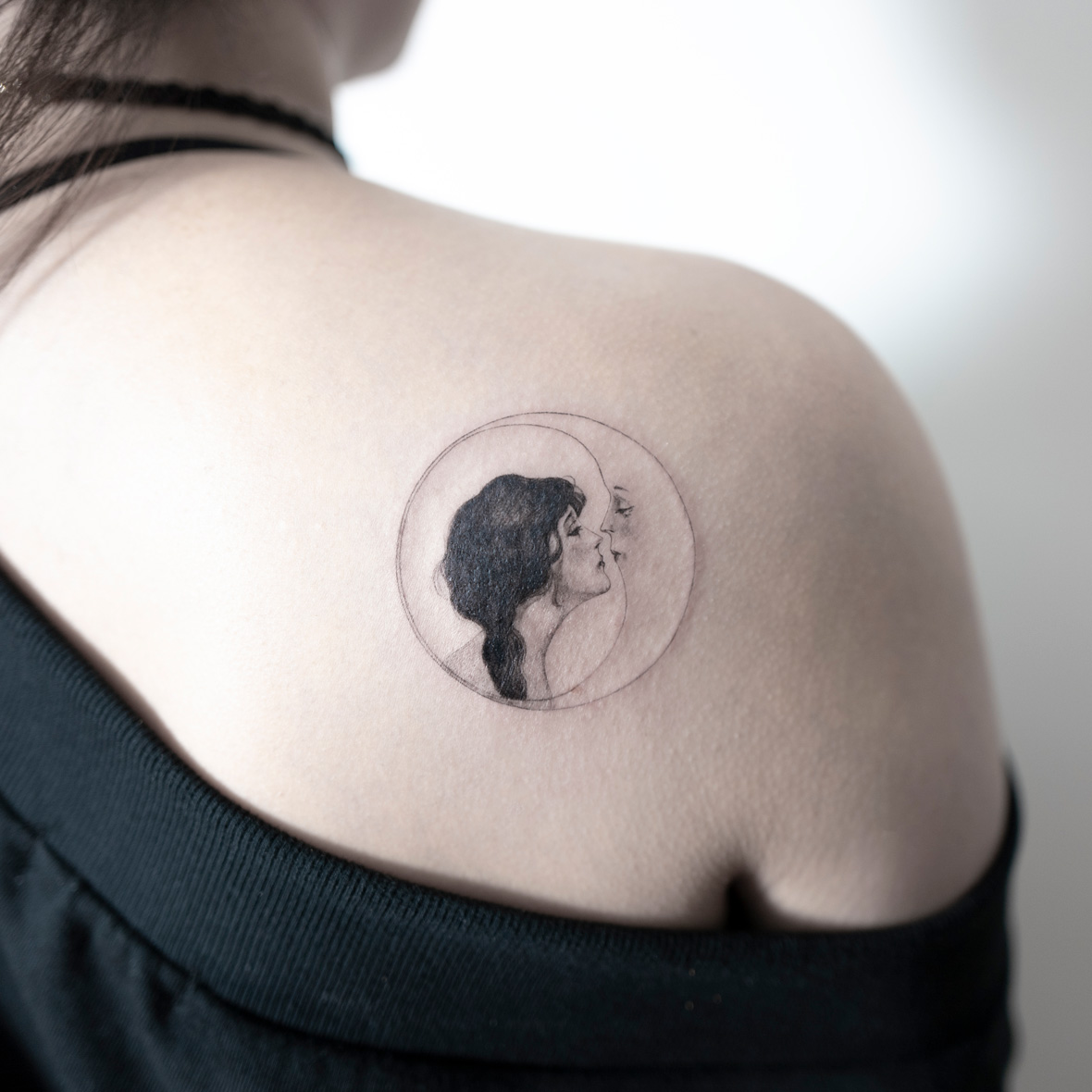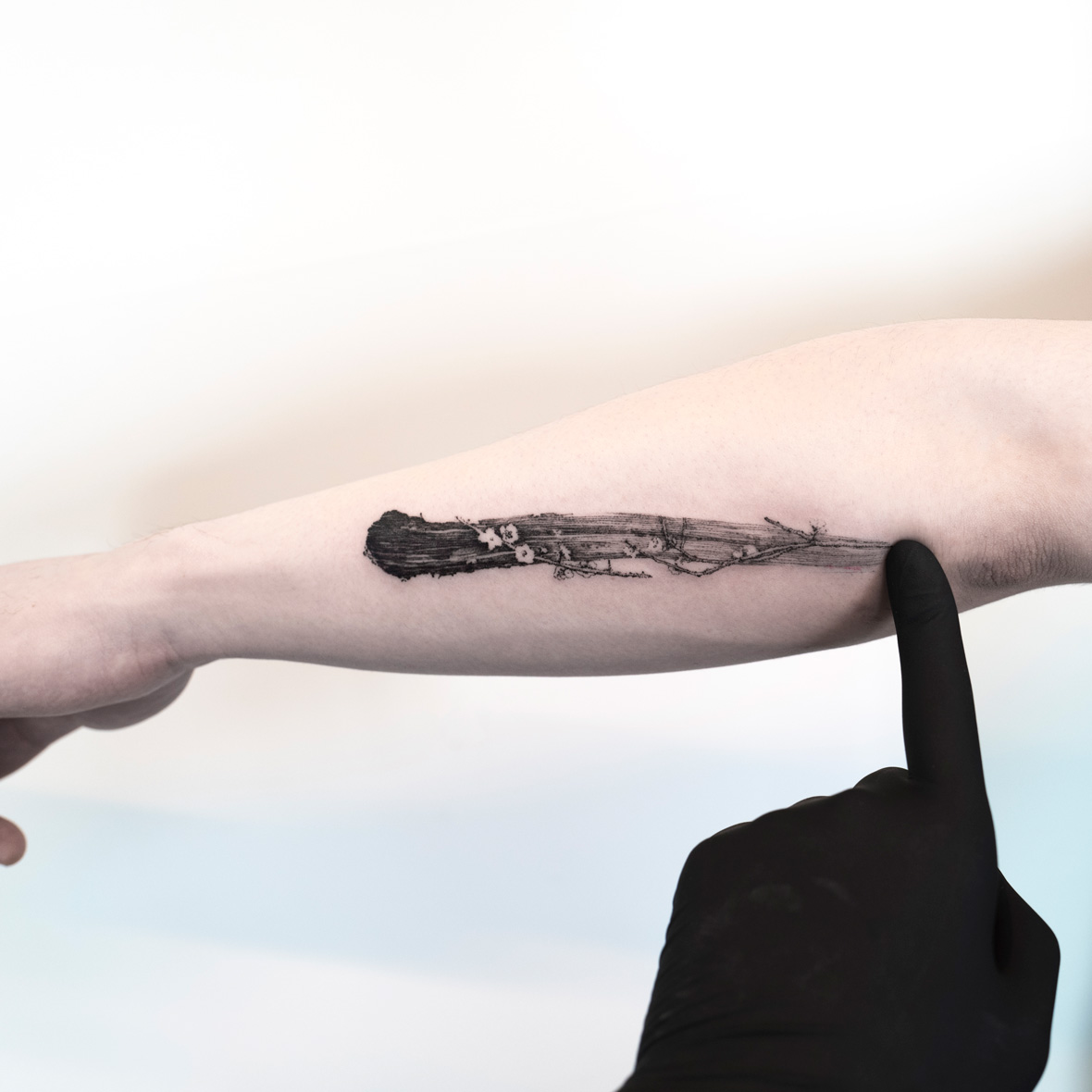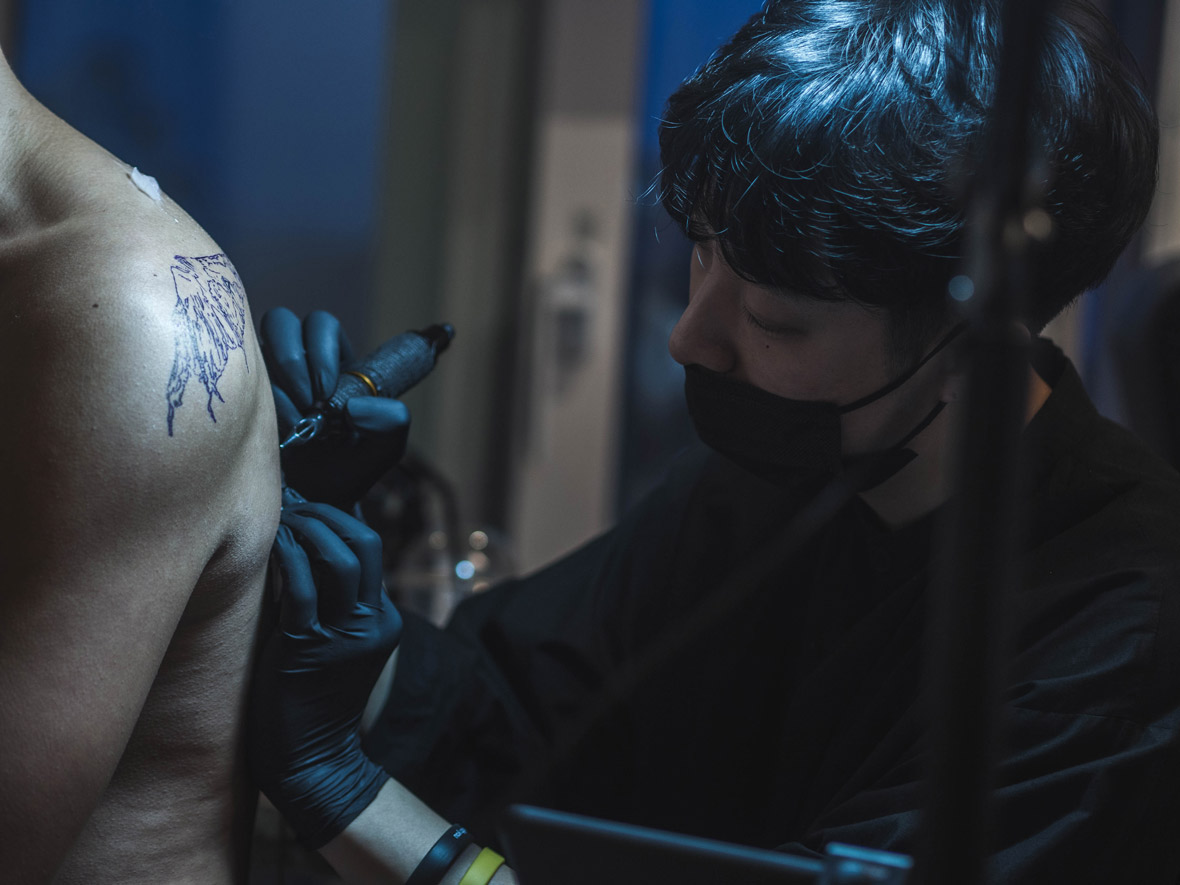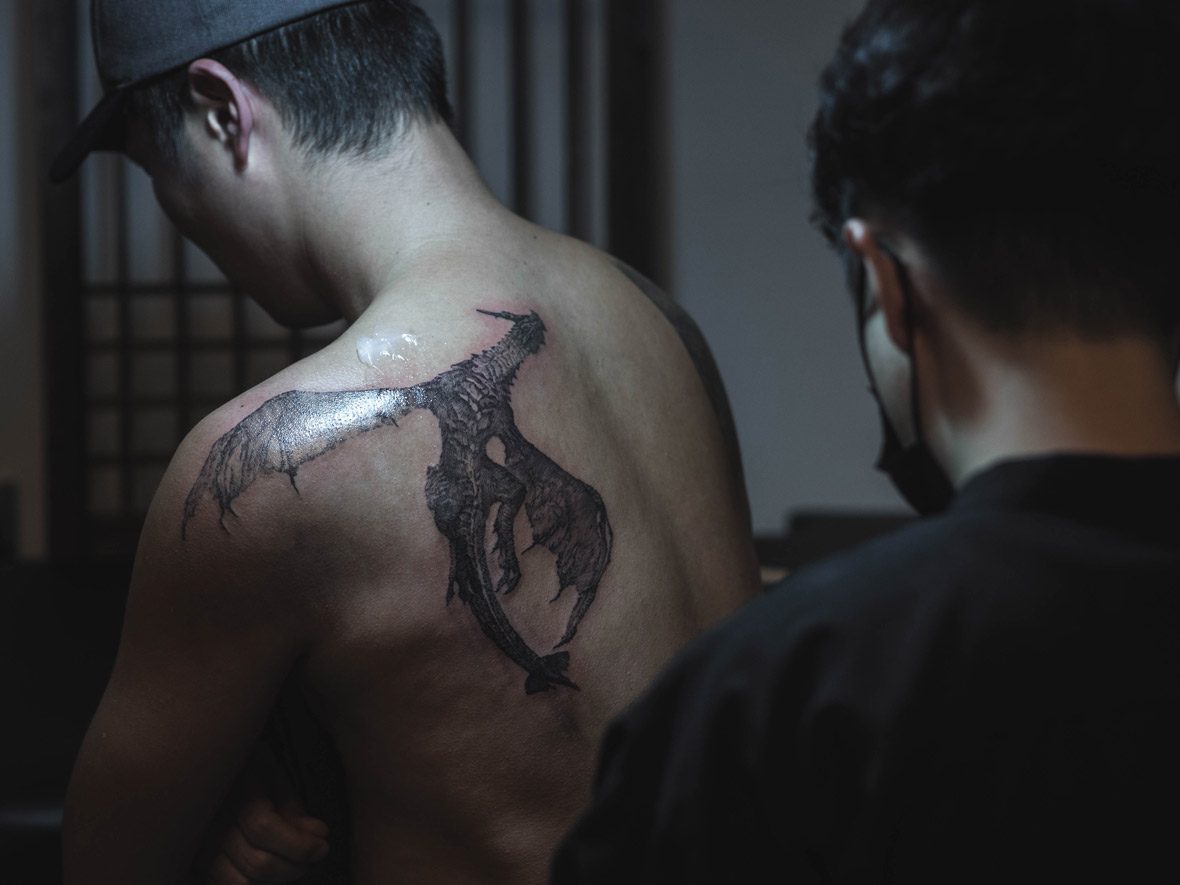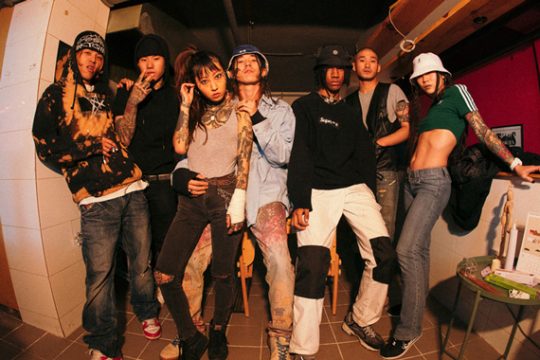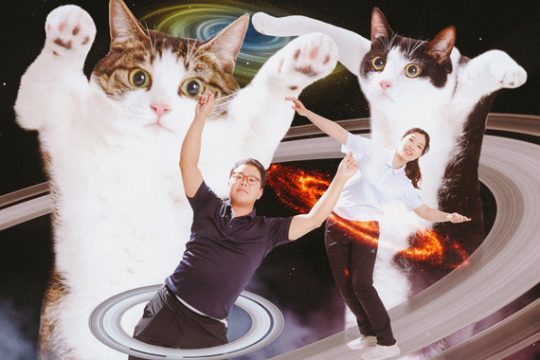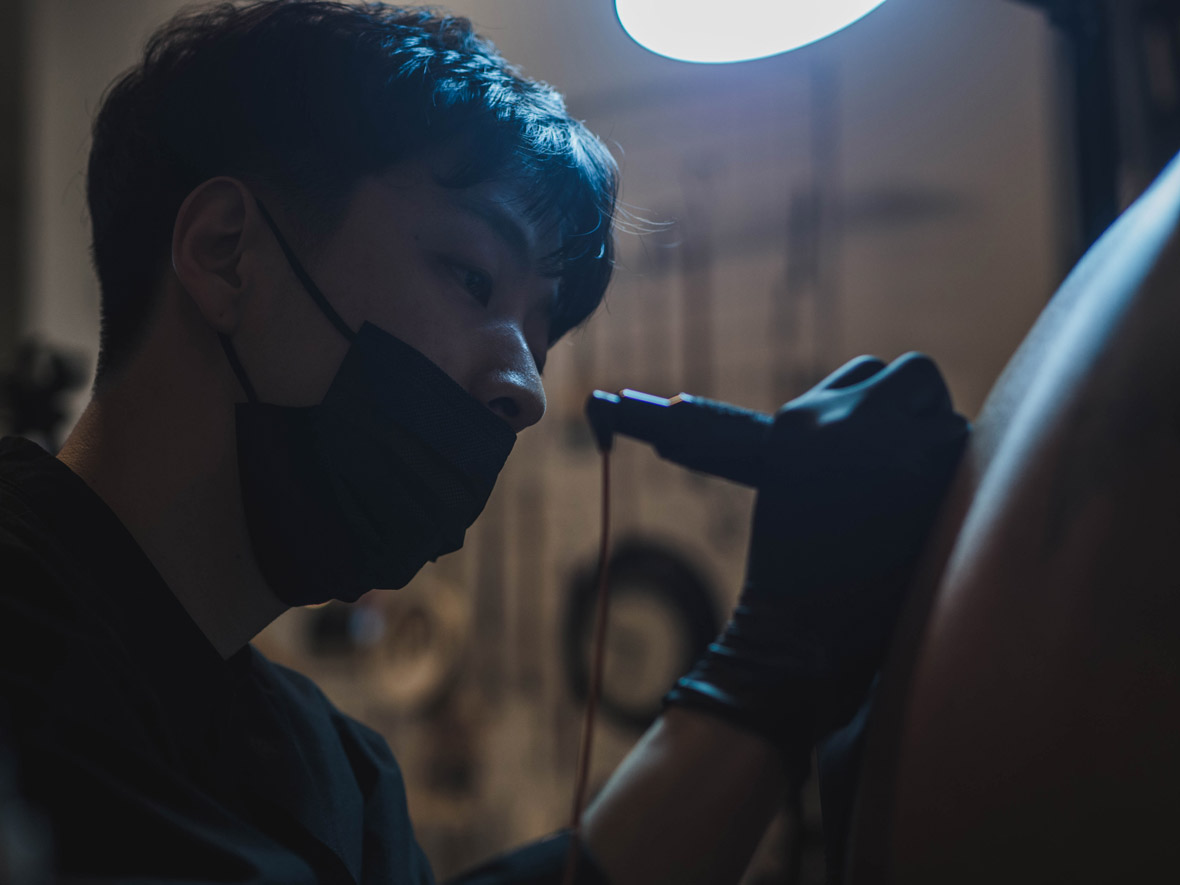
Ilwol Hongdam is one of South Korea’s most famous tattoo artists. He estimates that over the past four years he’s inked over 3,000 tattoos, and he’s recently begun traveling internationally to reach clients in Shanghai, Hong Kong, New York, and Paris.
Such a career was unimaginable in Hongdam’s youth: providing tattoos is illegal in Korea. Growing up, Hongdam steered clear of tattoos, which were associated with gangs. Only after graduating from college did he discover there was less of a stigma in foreign countries. He recalls being shocked by online images of doctors, police officers, and members of other respectable professions with tattoos. That it could be natural for a teacher to write on a blackboard with a tattoo exposed shattered his preconceptions at a time when he was having difficulty finding a career.
Ilwol Hongdam 是韩国最著名的纹身艺术家之一。他估算了一下,过去四年来他的纹身作品已经累积3000多件。最近,他开始环游世界,在上海、香港、纽约和巴黎等城市留下自己的纹身作品。
这样的职业在 Hongdam 年轻时是不可想象的,因为在韩国,纹身依然违法。人们总是将纹身与帮派联系在一起,从小到大 Hongdam 都尽量避免与纹身扯上关系。直到大学毕业后,他才发现原来在外国纹身并非是不良身份的象征。当他第一次在网上看到医生、警官或其他受人尊敬的职业工作人员竟然也有纹身时,感到十分震惊。一名在黑板上写着板书的老师,手上的纹身就这样坦然地暴露出来,原来这只是再普通不过的事情。当他为找工作而烦恼的时候,这个发现彻底颠覆了他的想法。
Hongdam’s background is in traditional Korean art, and from the delicate flower petals and gentle animals that abound in his work, one might expect this to have always been his interest. However, Hongdam says he originally wanted to pursue fashion, and was devastated when he was rejected from the department. Reluctantly, he enrolled in Korean Art and had a low opinion of it until he went to an exhibition by one of his upper classmates. “He wasn’t famous or anything, but his work—a large painting of a woman on silk—was so different from what I had thought of as Asian art.” Hongdam recalls thinking it only meant ink drawings on hanji (traditional Korean paper), so he was surprised by the mix of materials such as oil and acrylic. “It seemed like the division between Asian and Western art was breaking down, and I was shocked that Asian art could do so much, that it could represent things in new ways.”
Hongdam 学的是韩国传统艺术,在他的作品中,常常能看到那些精致细腻的花瓣和温和的动物。人们可能会想纹身就是他的兴趣所在,然而 Hongdam 说他最初想学的其实是时尚专业,当他被学校拒绝时感到十分挫败。最后,他不太情愿地进入了韩国艺术专业,一直以来他对这个专业都兴趣乏乏,直到他去参加一个高年级校友的展览。“他不是什么著名艺术家,但有一幅作品是在丝绸上画的巨幅女性画像,这完全颠覆了我印象中的亚洲艺术。” Hongdam 回忆说。他一直以为亚洲艺术就是在韩纸上的水墨画,所以他对于这种混合不同材料,譬如油画颜料和丙烯颜料,来创作的方式感到很震惊。“这打破了我心中关于亚洲艺术和西方艺术之间的疆界,原来亚洲艺术也可以有这样丰富的表现形式,我真的很意外。”
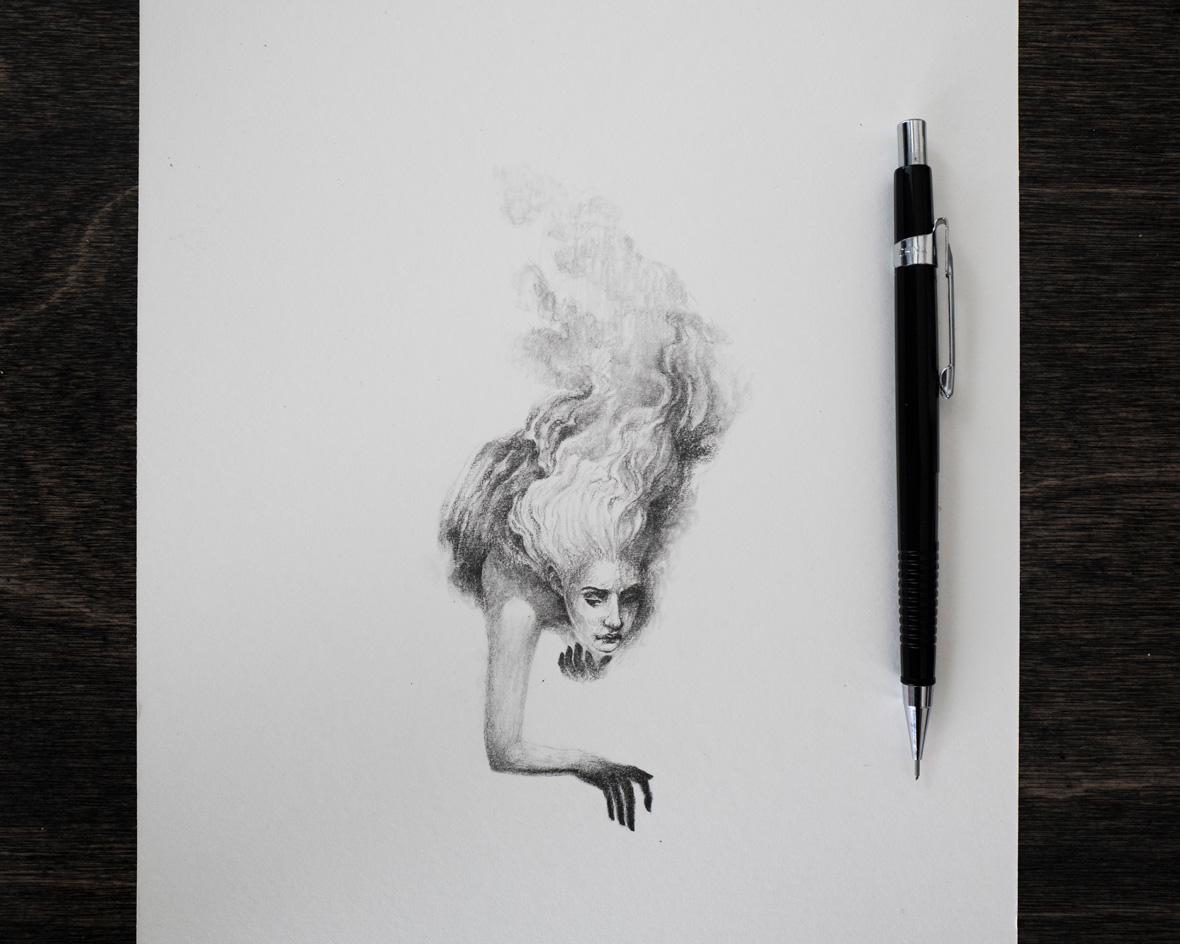
After working for a time as an art teacher, Hongdam turned to tattoos, both out of curiosity and as a way to keep drawing. Given his traditional training, this turn is both natural and unusual. Unlike irezumi (Japanese tattoos), which are characterized by thick lines that cover large portions of the body, Hongdam’s tattoos resemble the lighter, minimalist style of more traditional ink-wash paintings. One characteristic of traditional Korean art, he says, is that “the canvas is not filled but uses the beauty of blank space, the emptiness.”
在作为一名艺术教师工作了一段时间后,Hongdam 开始纹身的工作,一方面是出于好奇,另一方面也算是他用来继续画画的一种方式。既然他接受的是传统艺术教育,这一转变可以说是既自然、又非比寻常。不像 Irezumi(日式纹身)的线条粗厚,往往覆盖身体很大部分,Hongdam 的纹身则更精细、简约,就如同传统的水墨绘画,“ 传统韩国艺术是画布不会被填满,而是充分利用留白的一种艺术。” 他说。
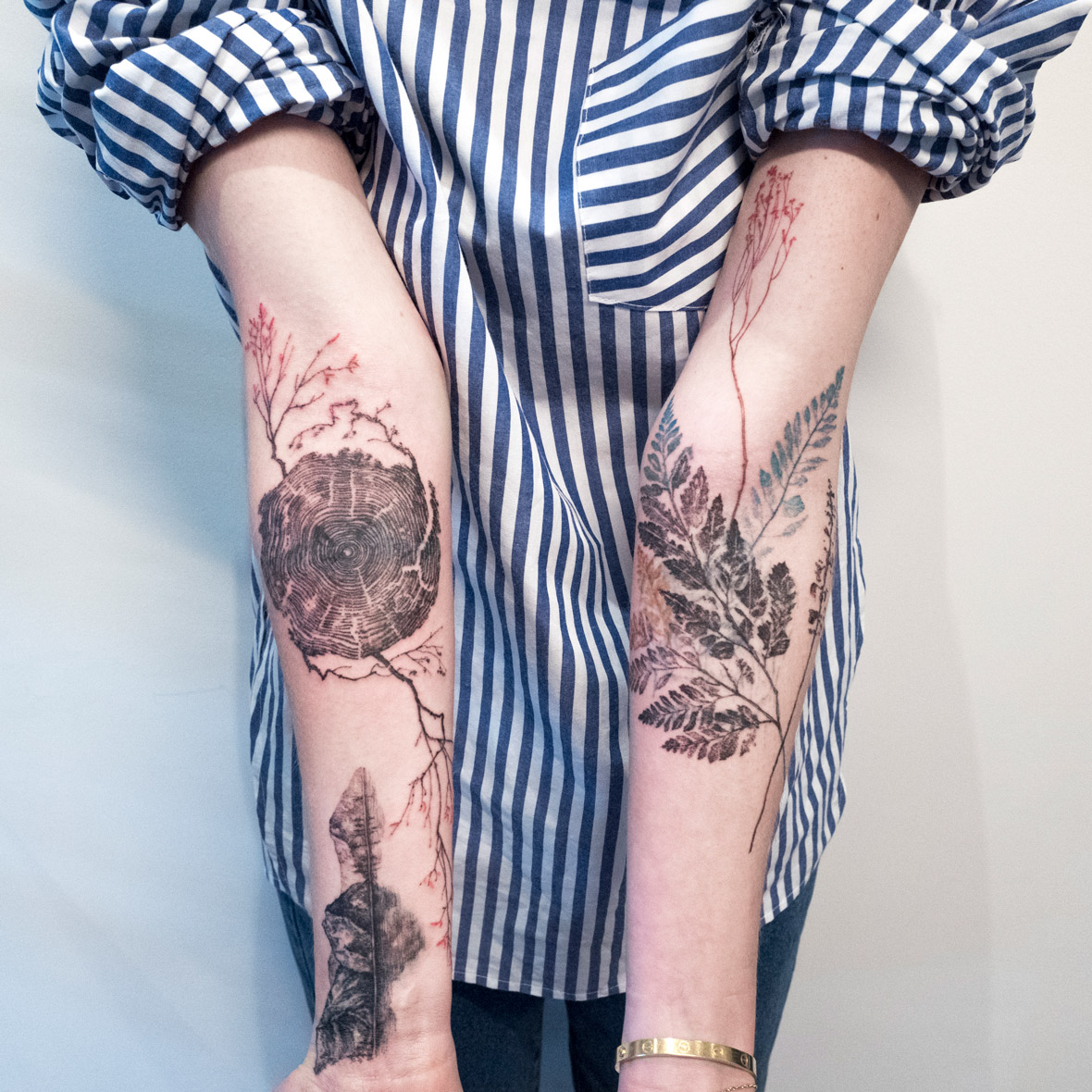
Hongdam also sees similarities between traditional Korean art and tattoo as a medium. Most of the material and sense of color comes from nature, such as muk (Korean ink), which comes from charcoal trees, and hanji, which comes from mulberry trees. Skin, too, is a natural medium, and Hongdam finds fascination in working with various skin tones, which bring out or tone down his art. He observes one more common feature: “You can’t fix mistakes in traditional ink paintings. You can paint over a mistake in oil, but in once you make a mark with ink, that’s it. That’s why traditional ink artists tend to work in constraint and under high pressure.”
Hongdam 认为,传统韩国艺术和纹身之间的共同点在于 “媒介”。大部分的材料和色彩灵感都来自大自然,譬如他所用的韩国墨水(muk)就是来自木炭,而韩纸则是来自桑树。皮肤也是一种天然媒介,在各种肤色上创作对他来说是一件充满魅力的事情,因为不同的肤色会突显或是柔和他的艺术。他还观察到这两种艺术间的另一个相同点: “在传统水墨画中,一旦画错了是没有办法去弥补的。这和油画不同,因为在油画中你可以直接在画错的地方上继续画,遮掉错误。但一旦你用墨水画多了一点,也就无可挽回了。这就是为什么传统的水墨画艺术家总是在紧张与高压的状态下工作。”
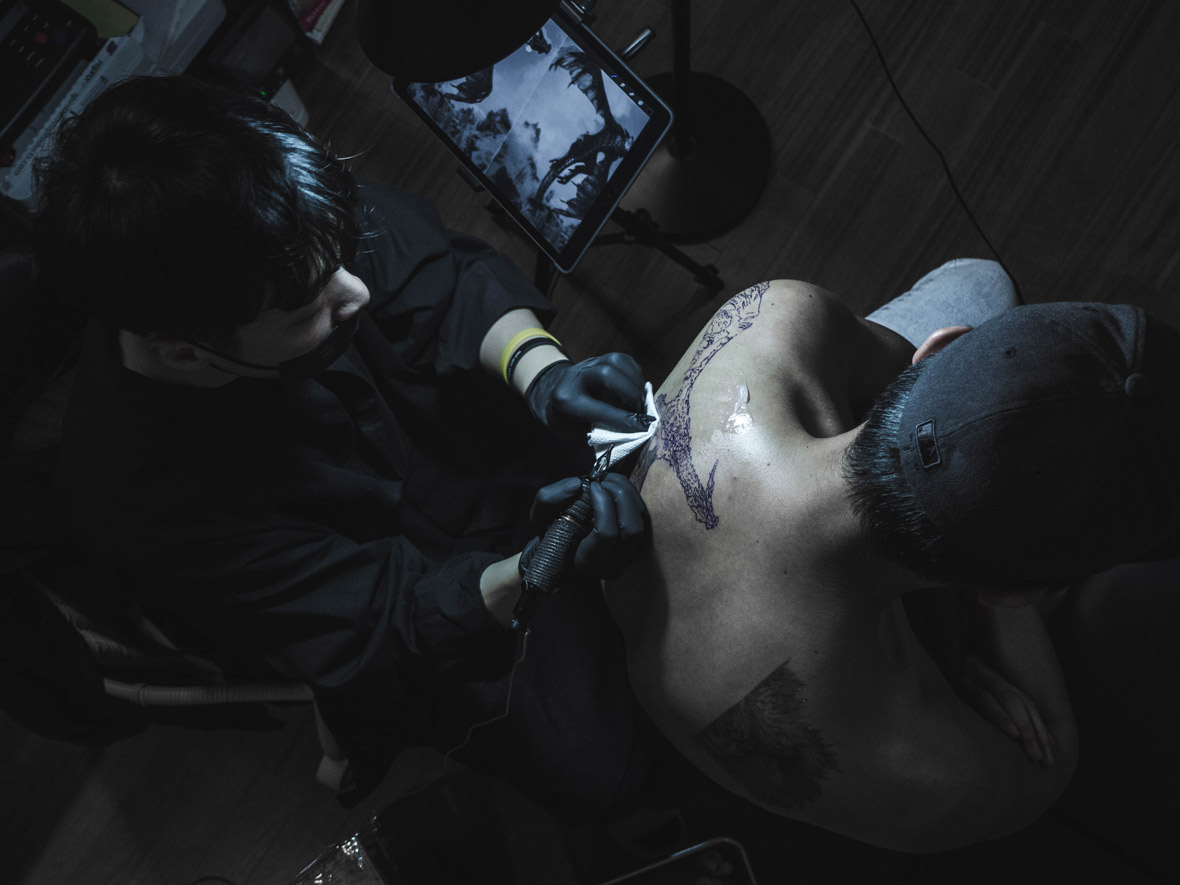
The pressure is even greater for tattoo artists, whose canvas is after all a client’s body. In this, Hongdam sees enormous responsibility. “You know how listening to an old song brings up memories of when you first heard it, like how it was snowing that day or how you were with your first girlfriend? Tattoos are the same. When you look at a tattoo you think back to the artist, and how you felt when you got it,” Hongdam says. “A tattoo you get in a bad environment becomes a scar. I keep this in mind because it’s really important, though it’s hard if the client is rude.”
Asked if he has any particularly memorable clients, Hongdam is quick to reply: “I remember so many of them.” Once he spent three days giving a tattoo to a dermatologist from Paris who specialized in tattoo removal. He’s even given tattoos to celebrities, though because he lacks a television in his office, he sometimes fails to recognize them.
Sometimes he still feels nervous, despite his years of experience in the business. “One time a client kept crying through the process. At first, I thought it was because of the pain, but he told me the tattoo was of his mother’s words, and she had just passed away.” Of course, many people get tattoos for much lighter reasons. “One foreigner said the first thing they drank in Korea was banana milk – which comes in a very distinctive can – and said they wanted it tattooed because it was their image of Korea.”
这样看来,纹身艺术家的压力甚至更大,毕竟他们的“画布”是客户的身体。也正因如此,Hongdam 觉得自己有着很大的责任。“你应该也知道,听一首老歌,你脑海里就会浮现一些回忆,想起你第一次听到它的时候,想起那天下雪,想起你和第一任女朋友在一起的时候。纹身也是这样。当你看到一个纹身时,你会回想起这名纹身师,想起你纹身当时的感觉。” Hongdam 说,“如果你是在恶劣的环境中得到这个纹身,那它就会变成一道疤痕。我一直提醒自己这一点,因为它非常重要。当然要做到这一点并不容易,特别是遇到不礼貌的客户时。”
当他被问及是否有什么特别难忘的客户,Hongdam马上说:“非常多。” 有一次,他花了三天时间给一个专业去除纹身的巴黎皮肤科医生纹身。他也曾经给名人纹身,但因为他的办公室里没有电视机,所以有时候就算是名人他也会认不出来。
尽管已经有多年经验,他有时候仍然会感到紧张。“曾经有一位客户在我为他纹身时一直哭。一开始我以为是因为痛,但他告诉我这个纹身是他母亲曾经说过的话,而她刚刚去世了。” 当然,很多人纹身只是出于更简单的原因。“曾经有一位外国人说,他在韩国喝的第一瓶饮料是香蕉牛奶,他觉得这种牛奶的瓶子形状很特别,纹这个图案也是因为它代表了自己对韩国的印象。”
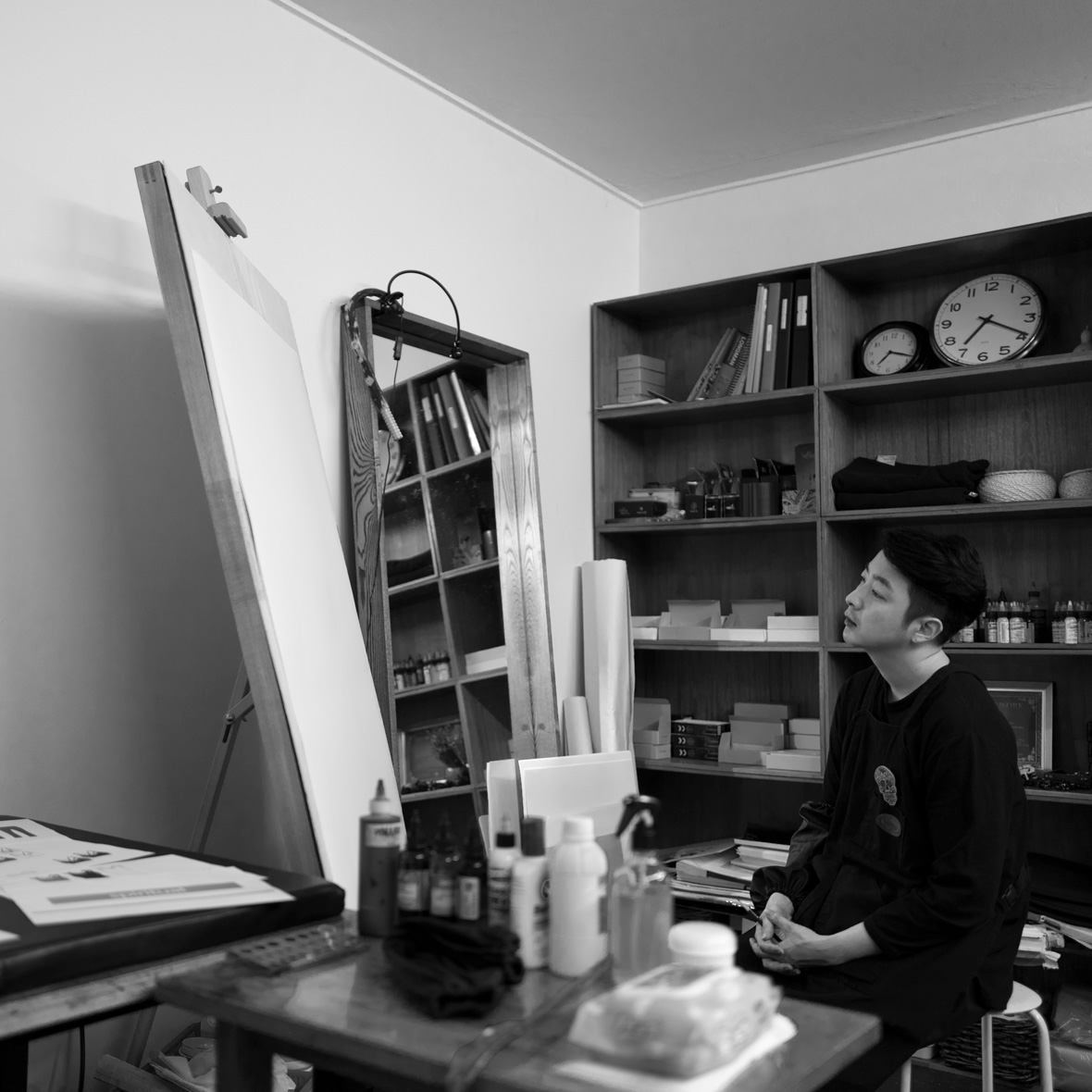
Even though Korea isn’t the first country that come to mind when one thinks of tattoos, Hongdam says the tattoo scene there is developing quickly. His age puts him somewhere between an older generation that still views tattoos negatively and a more open-minded younger generation, and this fact informs his work.
“Some people think of me as a tattoo artist and not an artist, which is surprising. To me, they are very much the same. Tattoo artists are artists. Some people work with wood or rocks—I’m just someone who works with skin. Why should people who do tattoos only do tattoos, or why should people who paint on canvas be restricted to that medium? I want tattoos to become a natural part of art and society.”
尽管说起纹身,韩国可能不是你第一个想到的国家,但 Hongdam 认为,纹身文化在韩国正在迅速发展。从年龄上看,他介于视纹身为不良标志的旧一代,与态度开明的年轻一代之间。
“有些人认为我是一个纹身艺术家,但又不是艺术家,这一点挺令人惊讶的。对我来说,这两者是一样的。纹身艺术家就是艺术家。有些艺术家用木材或岩石来创作,而我则是在肌肤上创作。为什么纹身艺术家就只能做纹身,为什么画画的人就只能用画布来创作? 我希望纹身能成为艺术和社会中自然存在的一部分。”
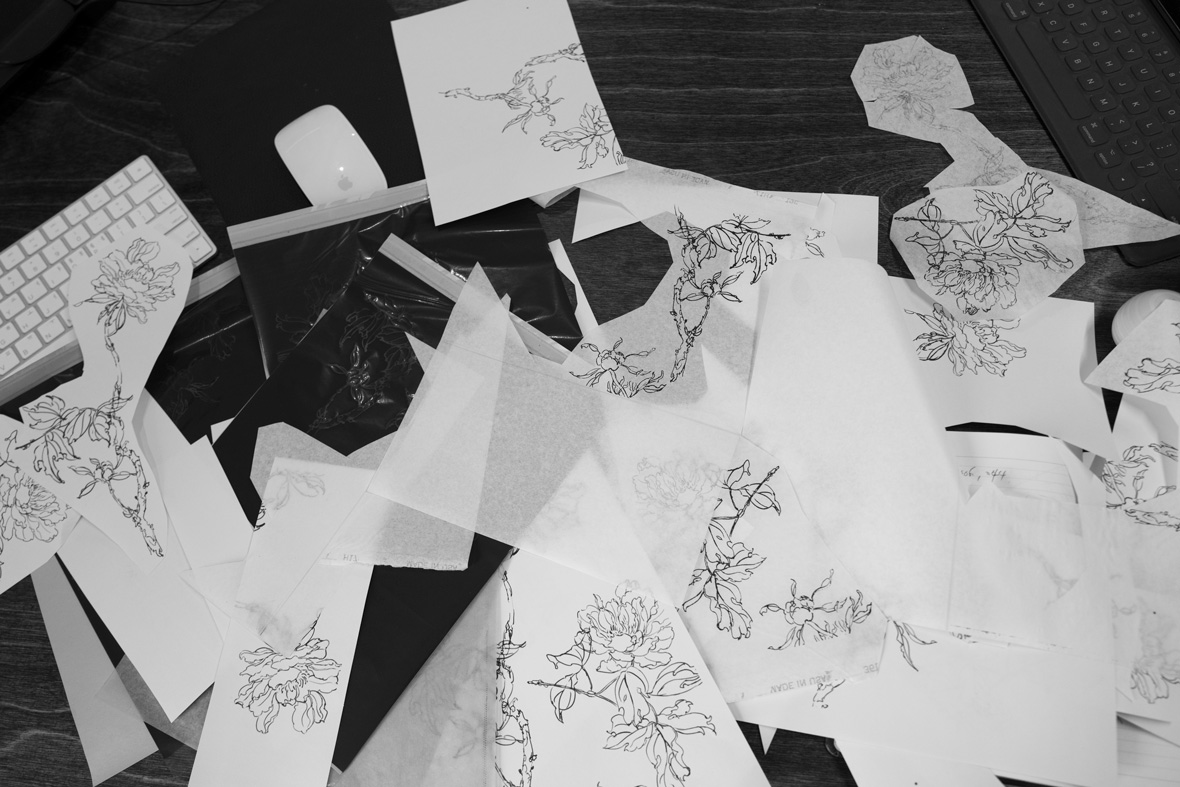
He’s not dogmatic about what tattoos should be, and he remains open to all kinds of inspiration. “I don’t want to be an artist who says tattoos have to be one way, or that ink painting should be another—I don’t really find that exciting or appealing. If we weren’t open to new ideas, we wouldn’t have watercolor tattoos, fine line tattoos, pictorial tattoos, or anything else. Though it’s intimidating to encounter ideas you disagree with, we have to be exposed to them, so we can either accept or reject them and see where to go from there.”
他不打算对纹身订下什么教条,他对各种想法持开放的态度。“我不想成为一个要求纹身必须怎样,或者要求水墨画应该怎样的艺术家,我觉得这样做很无趣。如果我们不接纳新的想法,就不会出现水彩纹身、细线纹身、图案纹身等等。不同的想法可能是一种挑战,但我们必须要先接触到这些不同的想法,才能决定要接受或是拒绝它们,再看看如何进行下一步。”

Hongdam hopes younger people see in him an example. “Other than deciding to be a tattoo artist, I’ve decided very few things for myself. Mostly I’ve followed advice from my parents or teachers. The first thing I decided after thinking about what I was good at and what I wanted to do was to become a tattoo artist,” he says. “So I have no regrets—this is something I’ve chosen. In art or anything else, I think it’s important for people to take ownership of their own decisions.”
“It’s a lot like tattoos,” he adds. “Clients often ask their friends where they should get their tattoo. And if they regret their decision, they blame their friends. I think choosing a path is a lot like choosing where to get a tattoo.”
Hongdam 希望年轻人能以他为鉴。“除了做纹身艺术家这个决定,我自己其实很少决定任何事情。大部分时候我都只是按照父母或老师的意见走。在我认真思考了自己擅长什么和想要做什么后,立即就决定成为一名纹身艺术家。我没有遗憾,因为这是我的选择。不论是艺术,或是其它任何事情,我认为对人们来说,自己的决定要自己做,这一点是很重要的。”
他补充说道:“这一点和纹身很像。一些客户经常会问他们的朋友在哪个部位纹身比较好。如果他们事后后悔,就会去怪朋友。我认为人生选择走哪条路,和选择在哪里纹身是一样的。”
Website: iwolhongdam.com
Facebook: ~/ilwolhongdam
Instagram: @ilwolhongdam
Contributor: Eugene Lee, Joe Park

